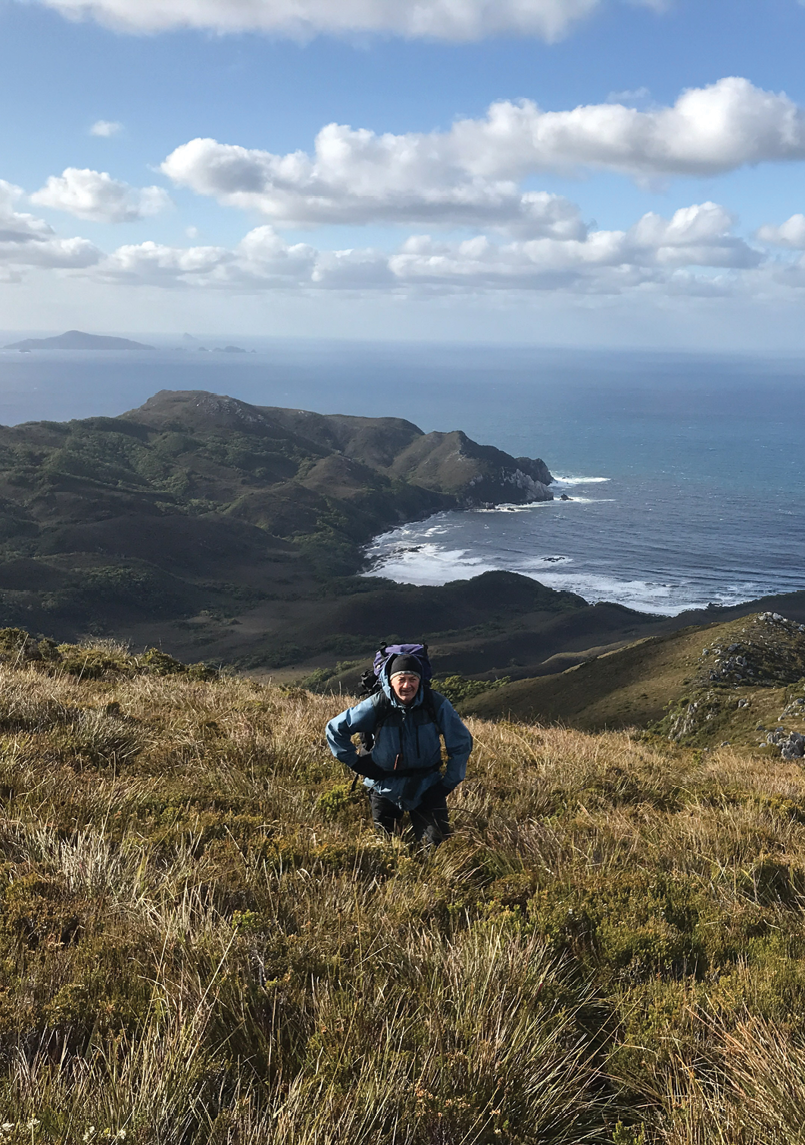


It’s dark, cold and wet outside at Wilson Bight. Lying snugly in the sleeping bag, I reach over to see the faint hands on my watch: 4 am. In a little over an hour we will be stirring to get ready for the day ahead. The rain has been smashing on the fly most of the night. The guide book predicts a ten to twelve hour day for our intended walk from Wilson Bight to Window Pane, climbing over a 700 metre range, possibly with high winds and often covered in cloud – we had better be ready for this.
Up onto the range - view of Wilson BightMarc Breton

South West Cape Circuit March 2020
Rob Wildman

18 | BWA August 2020
Common Brown
We had spent the previous day lounging, eating slowly, going for short walks along the beach (as there isn’t much of it), getting to know our fellow campers and acquainting ourselves with the possible next day’s route, the indistinct pad which leads up the mountain. We are now at Wilson Bight, which is the furthest bay west in a series of picturesque bays and beaches punctuating the coast along the South West Cape. The way out is either back along the coast or a big day over the range.
Eight years ago, in 2012, my walking partner and I attempted to do this circuit walk and had completely underestimated how much time was needed. We had then given ourselves one rest day at one of the beaches on the west coast but, after arriving in Hobart, we were grounded, as the “bottom corner”, the south east of Tasmania, was blanketed and the Par Avion pilots have to fly on visual only. Having lost the rest day, we decided, like many before us, to simply stay and enjoy the beauty of the southern beaches and abandon the trek over the mountain. On that trip we saw whales, dolphins and, on Ketchem Beach, we were kept company by an enormous elephant seal which we had mistaken as a rock for two days. The beaches are broad and always include a small fresh water stream trailing out from the hinterland. Often littered with jagged rocks, they are pounded by the relentless Southern Ocean waves which slide interminably towards the feet of the backing hills.
This time we had a real chance to do it, even though we had lost the first day to a cancelled flight, but we were not the gung-ho cavaliers we once were and vacillated all the previous day as to what we would do. The weather was going to be the real decider and the forecast was that the rain was clearing. We were lucky to have walkers Peter, Tom and Kate with us during the previous day as this group had done this same walk the other way only two years ago. Mind you, they had also done a 51 day walk down the West Coast from Strahan so we didn’t know
if we were talking to Chapman disciples or ordinary people. Turned out they were as uncertain as us as to whether we would get through but were throwing caution to the wind on our behalf by announcing “you’ll be right!”.
We were also supposed to be three but our walking mate, Joan, had decided that she would walk in from Scotts Peak Dam along the Port Davey track, a four day slog along some pretty boggy plains, and meet us at the airstrip at Melaleuca. When we met on the day we flew in, we took one look at her bruised and blistered feet, and she didn’t take much convincing that it wasn’t her time.
After a delayed start from Melaleuca at about 4:30 pm, we arrived at the first beach, New Harbour, about fifteen minutes before sunset. Joining us in the camp area were these silent sentinels of six one-man tents, all quiet and still. Was anyone there? We didn’t find out until the next morning when they emerged early and announced they were from the Coast and Mountain Walkers in NSW. A short conversation revealed they actually were all asleep the previous evening. The coordinated rise, shine, eat and pack of walking groups is problematic, almost militaristic for me, but at least they were out there. This beach is simply glorious and one could spend days just enjoying its nothingness, its noisy ocean and its serene forest at the back of the beach. In fact, a few days later we met two old guys (well, about my age) who spent four days just taking photographs on this beach.
This particular camp is also known for its cheeky quoll population who use the dark to sneak into packs and extract any food they can find. Which doesn’t quite explain why, when we were here eight years ago, they stole our toilet paper and digger!
New Harbour to Wilson BightThe track from New Harbour through to Wilson Bight leaves each of the beaches, heads through the scrub and very wet forests and emerges onto the clearer ranges over which it passes. The ups and downs are generally gentle and it is clear and graded. You always approach a new beach via some thick forest and burst out onto a beach, creek or lagoon, usually ringed with a grassy verge.
“This beach is simply glorious and one could spend days just enjoying its nothingness ...
BWA August 2020 | 19
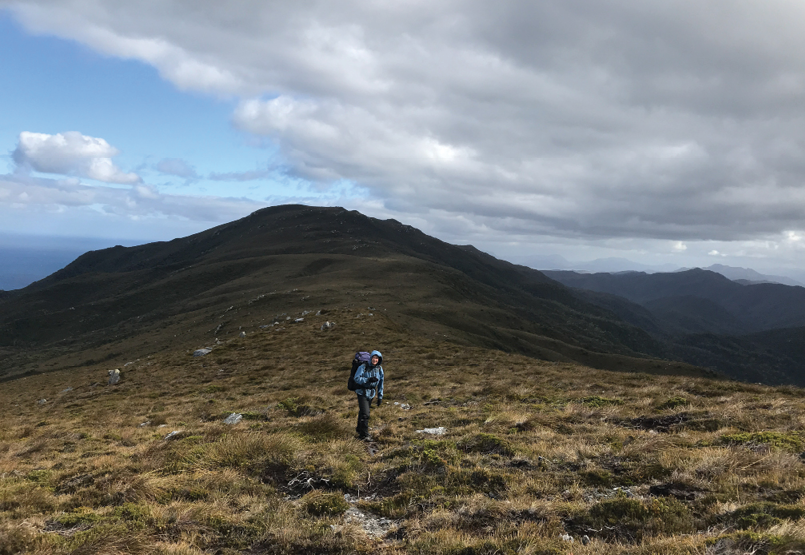

So when we were trying to find the exit on Hidden Bay, we had to laugh when we discovered a seal sitting squarely at the mouth of the forest track looking very soulfully at both of us, definitely not letting us get too near.
The track along these beaches climbs up onto some higher country as it attempts to circumnavigate the headlands. The day before we arrived, a woman was blown off the track, as we almost were, and on her
second fall, suffered a broken wrist. An EPIRB was set off and she was taken out by helicopter with her husband. Another woman, who had been staying at Hidden Bay and was suffering severe migraine pains also found space on the ride.
After a fairly strenuous six or so hour walk from New Harbour, we were about to round the last obstacle – the jutting rocks which divide the beach at Wilson Bight. This is usually not attempted at high tide but even at low tide it is treacherous. The rock knife spears right out into the surging surf but there is a break half way out. Here you need to time your run. I did, but running with a pack meant that I was unbalanced and came crashing down head first into the sand.
Over the TopNow sitting in the tent at five in the morning, we decided to go. Climbing up through the forest on the more recently used route, we ascended a ridge directly behind the camp site in the middle of the main beach on the west side. The cloud had not cleared but we were hedging our bets that it would.
Top of the range aheadMarc Breton
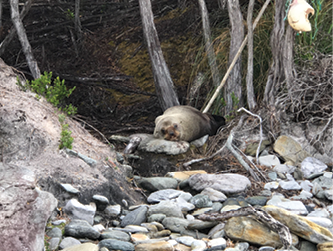
Seal on the track - Hidden BayMarc Breton
“Here you need to time your run.
20 | BWA August 2020


Once on the ridge the going is just up and further up until the pad peters out on the top of the range. This route is apparently not as spectacular as the old one up via Mount Karamu but we didn’t care; we couldn’t stop turning round and admiring the ever broadening view of the coast and the beach in particular. The heavy sky was also disappearing and we were enjoying some wonderful patches of sun. We took our time taking photos and just being awestruck at the wildness of this part of the world.
The pad which comes and goes along the top of the range always seemed to find the most vertical path up the intermediate knolls along the way and the ascent of the summit of the main range is quite intimidating from any distance. But as we got closer, the pad became clearer as it started to plough its way through head high scrub on the sides of the summit. At times it had become a creek after the massive downpour of the previous night and even on top of the range, there was so much water everywhere. We basically sploshed our way up.
Once on top we were transfixed by the views to the north and the south. The enormous sand drifts of Noyhener Beach were clear on the distant horizon to the north as was the final tip of South West Tasmania to the south.
We really couldn’t believe our luck with the weather but, of course, we noticed the wind had picked up and we still saw rain squalls out to the west heading our way.
At this point, it was time for some solemnity. I was carrying a small envelope which contained a small part of my son’s ashes. He had died in Thailand only a few weeks prior to this trip, and I needed to pay my respects to his memory from this place which was as close to heaven as I would get for a long time.
With a few simple words of goodbye, I tore the end of the fung pau and held it up to the breeze. As the ashes streamed out, I crumpled in a fit of tears and grief. Marc stopped taking pictures and gave me a bear hug until the sobbing subsided.
The route down to Window Pane Bay involved following the ridge, with its sprawls of granite rocks dotting the crest, to a large flat area where the first of the rusting iron stakes still sits, pointing out the original 1966 realignment of the South Coast Track when it passed over Mount Melaleuca. There are several of these
View north to Window Pane Bay and Noyhener BeachMarc Breton
“... pointing out the original 1966 realignment of the South Coast Track when it passed over Mount Melaleuca.
BWA August 2020 | 21
through this area and the pad follows them religiously to the end of a steep ridge which you need to follow until you reach the forest. The pad is generally easy to follow here but there are times when walkers have been in too much of a hurry and formed new pads leading nowhere in particular. Actually, in most of the forested areas along this coast, you need to be patient, and not rush ahead. The right track will be there.
And why would you want to rush through these forests? They are lush, moist and surprisingly quiet, making you want to linger and not break out to the cacophony of the surf. Because of the leaf litter floors in the forest, it is easy to see why the track becomes indistinct and there is a tendency to head towards the beach too early. On both Window Pane Bay and Noyhener, the forest track doesn’t actually reach the beach until almost the last minute, only a couple of hundred metres from the camp spots.
As we approached the outlet creek at Window Pane Bay, a secluded beach surrounded by wonderful tall sandhills topped with scrub, we noticed someone on the other side waving frantically at us to go around to our left. The creek was flooded and the route to the campsite now meant crossing through water up to our knees and flowing fast. We then met the waving man, Doug and his mate Dave, and we learned that they belonged to the party we had left at Wilson Bight. It wasn’t long before we heard many of the stories worthy of bushwalking legend from Doug, a history teacher from Newcastle. Dave, his mate, spoke with the broadest of Yorkshire accents and was one of those “quiet achievers”. They had taken it upon themselves to carry sharp garden saws so that whenever they met any opposition from the vegetation along the way, they would swiftly whip them out like a flick knife and clear the path. It was truly an unselfish task they were doing and on the following day on the way to Noyhener, we saw evidence of much of their work and thank them for their efforts.
We settled in for the night after listening to both of them describe the howling cyclonic storm they experienced the night before, where they were both sitting in their tents pushing against the sides, trying to stop their tents from collapsing while the winds tore in from the open Southern Ocean in the west. On the night we arrived, we had a very pleasant and peaceful time in comparison.
Window Pane to Noyhener BeachIn the morning, they set off to the south to join their friends and partners and we sauntered north, up through the pleasant forest trail which led onto the high plateau. Breaking out of the beautiful forest after about an hour’s walking, we again met the iron stakes! The placement of the stakes and the subsequent path joining them has all the hallmarks of a bureaucracy in its prime. The stakes basically form a straight line along the side of the hills and the trail attempts to follow them blindly, no matter what the terrain. We both had to laugh at how technology has changed so much in the intervening years and the need for such a rescue trail would be considered an unwanted expense on any government. However, we were grateful it was there, 30-odd years after it was built.
Once past the stakes and down into the forest before Noyhener, the same confusion with track finding returned. There were many attempts by previous walkers to head west to the beach but we always seemed to find yet another branch of the track which kept us in the forest. Doug and Dave’s recently cut branches became our new route-finding tool, as well as the occasional pink ribbon. Mind you, it wasn’t the “super highway” Doug promised. The real track finally finds the beach only a couple of hundred metres before Murgab Creek and the wonderful camp site in amongst the coastal scrub. The temptation to get our feet into the water and sand saw us slinging our boots around our necks and splashing up the creek to the sand ladder which leads up to the entrance of the camping area. The overcast sky had disappeared so we dumped our packs and just went walking in the surf and the sand with an afternoon sun dipping low in the sky.
“... the forest track doesn’t actually reach the beach until almost the last minute ...
“We both had to laugh at how technology has changed so much ...
22 | BWA August 2020
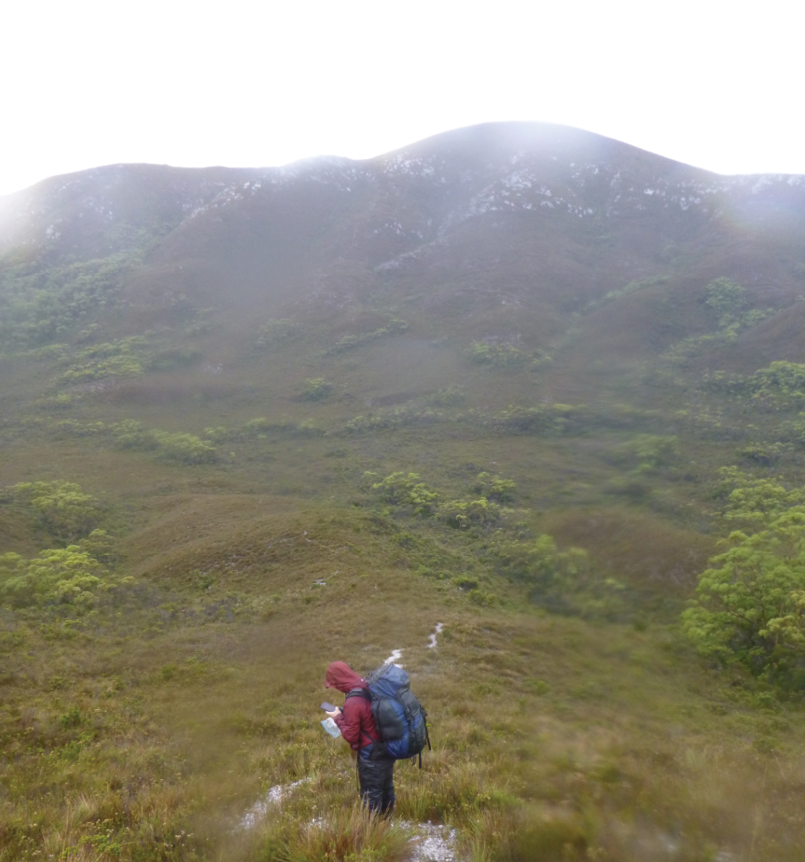

Port Davey Track and Melaleuca We originally had planned for two days here, but now with only one day available, we decided to just explore the beach, the sandhills and the headland. We also wanted to investigate two things: one was the route to Stephens Bay (and hence through to Spain Bay) and the other was our route out the next morning, as all I had read were reports on how confusing this section was going to be.
Halfway along the beach, a low sand blow channel went off from the beach and after following this for only one hundred metres, it hit the scrub. However, we found a few footprints which descended a small hill of sand into a pool. Just beyond the pool was the end of the very large sand blow extending from Stephens Bay to where we were. I was told later by my new acquaintance Doug, that this was a track they cut a couple of years ago. It is marked from the beach by ropes
Heading to Hannant Creek and the Pasco RangeRob Wildman
BWA August 2020 | 23
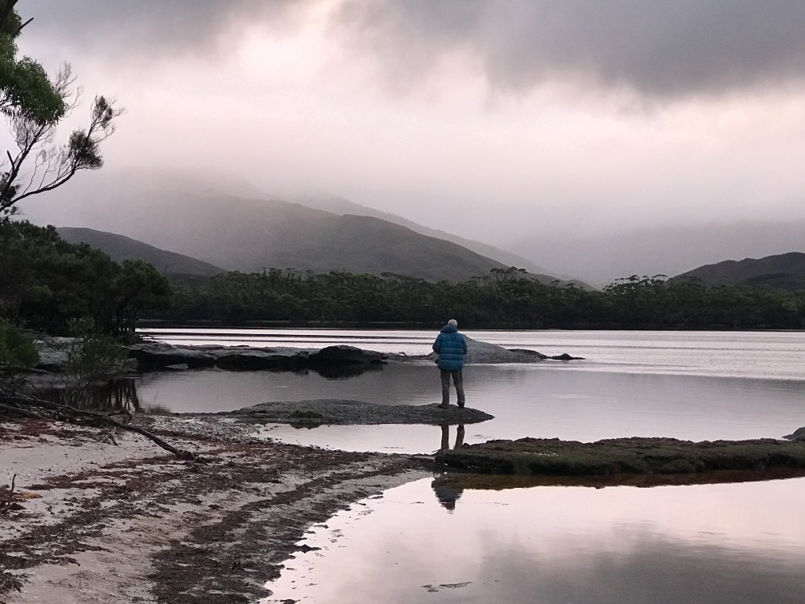

hung around some debris. While we couldn’t get around Chatfield Point (the other route to Stephens Bay), I was told that at low tide it is possible to negotiate this route.
At this stage in our walk we just wanted to mull around on the beach, explore the debris deposited on the sand from all the boats and kick up the kelp which was abundant. It was a spectacular day and we were on holiday, so walking to reach a destination was the furthest thing on our minds.
Having just completed our packing the next morning for the walk out to the Port Davey track, we heard the familiar sound of rain smacking the leaves above us. Our only real concern now was whether the clouds had descended low enough to cover the two mountain ranges we needed to cross. We had general directions set up in the GPS units but we were also expecting the pad to disappear a lot more. Just after the beach exit, the track heads up a ridge virtually east of the camp ground but then, once the crest is achieved, it appears to follow this ridge
to the north. Here is the first mistake made by many. The old track actually descends quickly via the first small gully down to the plain on the other side of the ridge, even though almost all traces of it have disappeared.
Finding it again, we looked ahead at the first major climb of the day – the South West Cape Range. While not that high, it does go straight up and we found ourselves stopping continuously to look back at the beach and the Jurassic-like valley we had just emerged from. With the rain deadening any sound, it was quite a pleasant but eerie place to be.
At the top of the range, the track hits the button grass and promptly disappears again but with a little scouting we finally found it going down the other side on a ridge further south than we expected. No matter, we headed down to Hannant Creek, had a quick bite before hitting the next major climb, up and over the Pasco Range.
Again, the button grass on the top of the
Horseshoe Inlet with approaching rain on the Pasco RangeMarc Breton
24 | BWA August 2020
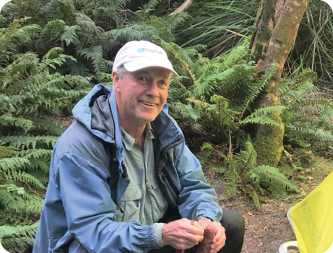
Rob is 67 and is based in Sydney. He has been bushwalking since the age of twelve, when he was dragged up The Castle and into a casual love affair with the bush. For years his stomping grounds were the Budawangs, Blue Mountains and Kanangra but Tasmania and the Snowies have been poking their nose in for a while. He often tries out poor unsuspecting first timers on impossible routes but somehow always makes it back to safety. Well, there was that one time with the helicopter ... For Rob, going bush is where the rejuvenation of the senses and the intimacy with nature always happens.

Pasco Range had us trudging around searching for the route. The wind had increased considerably and our faithful pad seemed even more elusive as we were thrown off balance trying to force our way through the long grass. After going in circles for some time, the cavalry came through and we found a large rock cairn indicating the way. Knowing how much further we still had to go, and having no relief from the rain, this was probably our low point.
The long ridge that leads to Horseshoe Inlet was a welcome relief after dealing with the high winds and rain of the Pasco Range. The track, after dealing with the scrub around the inlet, bursts out to the most serene scene. The edge of the inlet is covered with a rich, grassy cordon with a deep layer of black soil covered in super green grass, and the floor of the inlet is a fairly solid mix of rock and earth, easily navigated. We turned around to see where the track left us at the inlet and could not work it out. How would anyone find it going the other way, we wondered?
The last known obstacles before a welcome camp were the three creeks we needed to cross. Luckily, two of them could be waded after heading out into the inlet, but Horseshoe Creek itself was a swimming affair. We were shocked at how warm the creek was, after nearly becoming castratos in Murgrab Creek the day before. Picking up our packs, suddenly, our laughter killed the seriousness of the moment because our trousers, just above the gaiters, were full of trapped water forming huge marshmallow bulges.
After drying out at the superb camp spot and stuffing ourselves with some wonderful curry and dahl, we wandered back down to the water’s edge as the rain had finally stopped and an incredible calm had descended. Only a calling water bird way down the other end of the inlet pierced the tranquillity of this scene. No one spoke. We felt very privileged to be able to just let this unusual moment wash over us.
The return along the Port Davey track is a quick four hour walk with some mud but generally a good track. Approaching the airstrip, we noticed two Par Avion planes
descending to pick up walkers. When we were almost within shouting distance of the planes, they quickly careened down the strip and disappeared into the sky over Cox Bight. We found out later that Joan, our walking partner was on board, as well as Doug, Dave and the other three from Wilson’s Bight. There had been no flights in or out during the last two days so they all must have been keen to clear out from the stuffiness of the walker’s huts.
With an hour of Wi-Fi available, courtesy of the airline, Marc posted a goofy selfie of the two of us to our loved ones just letting them know that we were alive. What it didn’t say to them, and what you could never encapsulate in a photo, was all the experiences, the highs, the views, the tears, the food, the hugs, the wildness, the vastness and the memories of the last nine days. That was now deep inside our heads and our hearts.
BWA August 2020 | 25